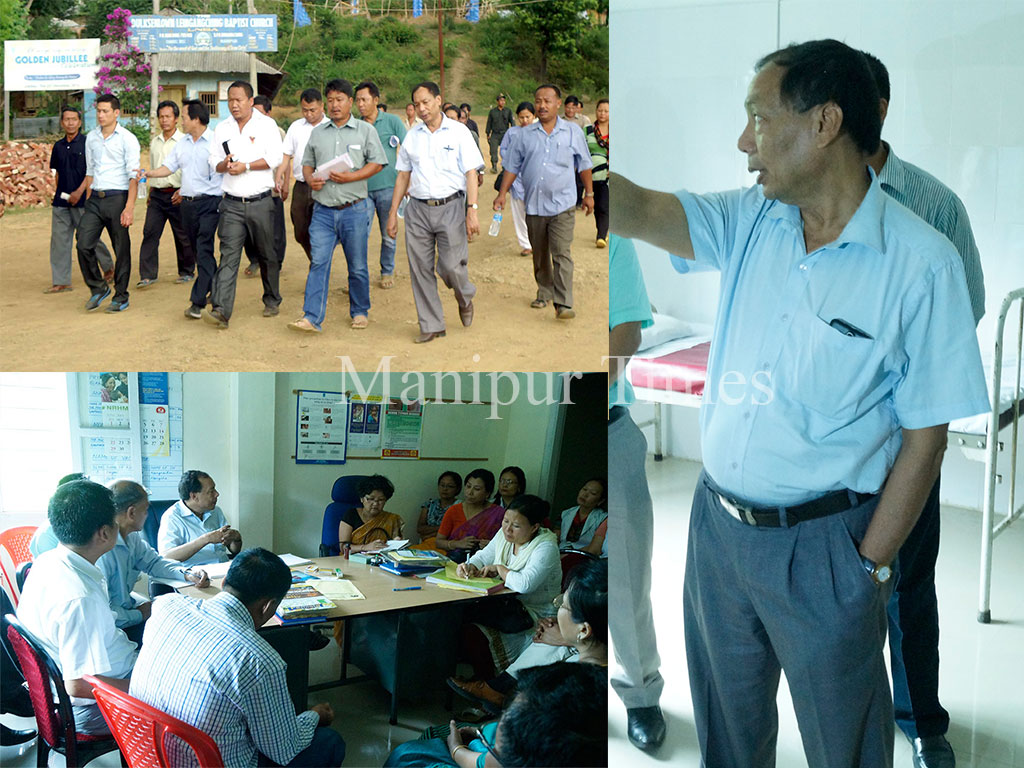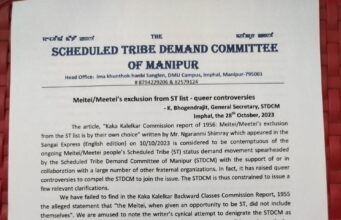 National Rural Health Mission was converted to National Health Mission which became operational in the State since last October. NHM is a combined mission that includes all Health Services. It is operational under five parts says Okram Ibomcha, State Mission Director of NHM Manipur in an exclusive interview with Manipur Times.
National Rural Health Mission was converted to National Health Mission which became operational in the State since last October. NHM is a combined mission that includes all Health Services. It is operational under five parts says Okram Ibomcha, State Mission Director of NHM Manipur in an exclusive interview with Manipur Times.
Okram Ibomcha was a topper in matriculation exam in CBSE for North Eastern Region (That time class eleven exam is considered as Matriculation exam). He also topped the Higher Secondary Exam of Manipur conducted by COHSEM. Pursued MBBS from RIMS and completed MD from AIIMS. He was posted in Thoubal, Tamenglong, and J.N Hospital (as a surgeon). He joined the administration in Health Directorate during 2009, now he is serving as a State Mission Director for National Health Mission. Since he joined office many development have taken place in National Health Mission as well. We go into the functioning of NHM as Okram Ibomcha spoke on the already implemented projects and ready to roll out ventures which would be quite informative to the general public for a successful healthcare approach.
RBSK free treatment for children from birth till 18 years of age.
“We have selected 76 Ayush Doctors, conducted exam for recruiting nurses and other staffs to implement the project in Manipur.
Girl child who attain the age of 13 are vulnerable to Anemia as they grow fast during this time and their mensuration began so we started a project call WIF where iron folic tablets are distributed free of cost in the government schools.
Every student boys or girls who had meal are given the tablets during school hours. For those who have not taken lunch the school authority keeps the tablet for the next day.
The tablet is also distributed to Anganwadi centers for distribution to non-school going children.
Under RBSK major disease also will be treated. In RIMS we will be having a separate space measuring 70 to 80 square feet. Same with JNIMS for National Health Mission very soon. We will have separate department for all kinds of illness and all cost will be borne free of cost for child under 18 year of age by the government. In the next three or four months or before Christmas we are going to inaugurate a separate NHM building. After the State Government allotted us the land we will start the construction works and completion will be in months’ time as we follow targeted time”, remarked Okram Ibomcha State Mission Director.
Another scheme called RKSK meant for age group between 10 to 18 years is also a new project about to start.
Urban Health Mission
“Urban Health Mission will start functioning in Imphal East, Imphal West and Thoubal area first of all and then it is expected to roll out in the rest of the districts. The project will be operational in the municipality areas. It will target the poorer section of the society who cannot access health services at their own cost. However anybody can access the service. It will deal mostly in basic health care services. Rich people will prefer to go to private hospital. It will have Mobile health units and there will be medical camps. With the mission neglected population will be covered and there will be proper health services”, the director informed.
National Health Centers and Mobile units across the State.
NHM is operating in 17 Community Health Centers across the State. Also in 85 Primary Health Centers, 421 Primary Health Sub Centers. The government of India have approved setting up of another 45 PHSC in Manipur and we will also give service in the new centers.
In Hill District we have four wheel drive service. In valley we use Maruti van. Mini caravan Mobile medical unit van is with District mobile medical units. Ultrasound, proper laboratory for blood tests, diabetes tests and other facility is provided in the mobile unit wheel. Two such vehicles is functioning in every district. Altogether there are 18 such vehicles till now. Doctors, nurse, lab tech goes with the mobile vehicle. Free medicines are also kept in stock for distribution.
Five parts of National Health Mission where one can avail certain facilities:-
“ Part 1 – is dedicated to pregnant mother and Child after delivery. Starting from the time of pregnancy till childbirth one can avail free service under NHM. After birth and until the child attains 18 years one can also avail comprehensive treatment free of cost. The scheme comes under the banner RMNCH+A scheme.
Part 2 – National Urban Health Mission in Manipur is about to launch in three districts of Manipur very soon and in the rest of the districts’ municipal areas. For that we are about to recruit 30 more staffs. A sum of Rs. 188 lakhs was already sanctioned a year back for the implementation works.
We are trying to form Urban ASHA. In Urban there are many poor people who are unable to access health facility including the immigrant populations. They could not find time as they keep engaging for day to day earning. They seldom have time to stand in queue at the hospital to access health care.
Basically urban health mission is targeting for weaker section of the society however anyone can approach for service.
Part 3 – of NHM vertical program – TB, Leprosy, Malaria, Blindness, Mental Health, Iodine Deficiency etc. it needs a coordinated approach with all the departments like the State TB Department, Department of Malaria etc. In Manipur we are yet to integrate for a coordinated efforts. We will work out very soon their fund is routed from us now.
PART 4 – includes treatment for non-communicable disease like Diabetes, Cancer, Iodine Deficiency, Burn and Trauma care like Accident etc.
PART 5 – is on infrastructure maintenance for repairing buildings”, says the Director.
Infant Mortality Rate and intervention by NRHM
“All India Infant Mortality Rate for India was around 250/300 in one lakh child birth, two or three years back. After NRHM started implementing its mission, it is being brought down to only 42 deaths now.
World Health Organization sets a goal of only 28 Death by 2015 in its Millennium Development goal.
Mortality rate for India for children under 5 years is presently 61 and it is to be brought down to 42 by 2015 in WHO’s Millennium Development Goal. Further for Planning Development of India it should be brought down to only 33 by the year 2017. Currently for Manipur it is 12.5 in 2014.
Maternal Mortality rate for India is 196. By 2015, WHO sets a target of not more than 109 deaths in its Millennium Development Goal. By 2017 at the end of 12th five year plan it should be minimize to 100 as per Planning Commission of India. In Manipur presently the figure is 70, as such in healthcare we are far advance. However we need to be more progressive for minimum casualties.
World’s lowest IMR 1.9 is scored by Singapore. While the highest IMR is 156 at present with Afganistan”, says shared the director.
Present Gap Analysis and work out
“As a Mission Director I make certain visits in a month time as targeted visits. By 2017, we can easily achieve the 6 death in 1 Lakh child birth on IMR set by Planning Commission of India. We were lacking in hill area. Gap analysis has been done and we try to come out with solution. As such during the recent visit at Chandel we have appointed a nurse at Sajik Tampak where not a single institutional delivery is done. The operation theatre in Chandel District Hospital was made operational and Caesarean delivery is done. Likewise Churachandpur and Thoubal District Hospital through remodeling and restructuring of the operation theatres. Chakpikarong Community Hospital was converted to 24/7 and X – Ray machine and ultrasound machine were allotted during my visits. Komlathabi health centre will have a labour room for institutional delivery and all the requirements were released from the head office. And Laingangching will have a new PHSC building with locals providing land for the same. Senapati District Hospital will be open to the public with operation theatre and Gamphalong Primary health center will start giving institutional delivery after a visit and finding out gaps and up gradation on certain things like water and electricity supply.
I use to make 15 to 20 visits in a month including the vicinity area in the capital. We also need to work out in nearby areas. As in the case like Ambulance kept at Akampat health centre which record only two service a year has to be given away in high case load area as per instruction from the Union Ministry. We need actual findings and visits help in proper study of the situations. We also have an instruction of keeping the trained staffs in high caseload areas, “continued Okram Ibomcha.
To be continued..











